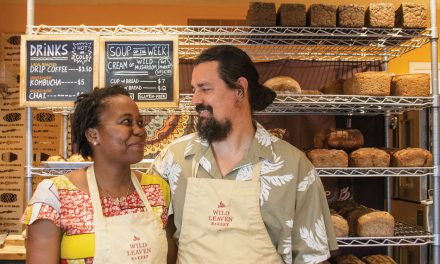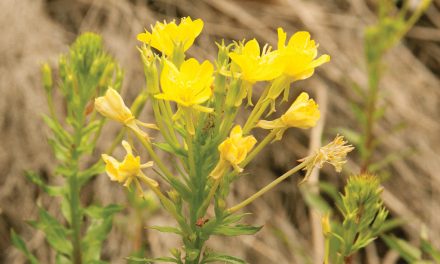Words and Photos by Anna Marija Helt

Boletus rubriceps at different stages.
The joy of finding wild mushrooms can be prolonged by making a cooked mushroom powder for year-round use in the kitchen. The powder doesn’t need reconstitution in water before use and adds flavor, protein, fiber, vitamins, minerals, and other good stuff to your recipes.
Mushrooms abound in New Mexico, and those featured here are delicious and easy to identify. That said, proper identification is critical, involving much more than a photo or article. Use a couple regional guidebooks. Join the New Mexico Mycological Society. Go on forays and take classes led by experts. Mistaken identification can provoke a prolonged trip to the bathroom, or to the hospital, or—in rare cases—to the cemetery. Be well educated on your mushroom of interest to avoid being in one of these unfortunate groups.
Oyster Mushrooms
Oyster mushrooms are valued as food in Asia, Africa, Europe, and North America. Their medicinal usage dates back thousands of years, and some of these uses, such as for respiratory infection and blood sugar regulation, are also supported by clinical research.
After a good rain, aspen oysters (Pleurotus populinus) and lung oysters (P. pulmonarius) fruit—often in clumps—on dead or dying aspen and cottonwood trees. The mushrooms are fan or oyster shaped and range in color from creamy white to light buff to gray brown. The light-toned gills underneath radiate from one side of the mushroom. There may or may not be a short, off-centered stalk with the gills running down it. These fungi smell pleasant and mushroomy, sometimes with notes of anise. Their mildly sweet, earthy flavor works well with risotto, scrambled eggs, and “sweet” seafoods like scallops.
Puffballs
Like oyster mushrooms, puffballs are eaten around the world. They’re also applied as treatment for burns and abrasions, and even used for entertainment. (Puffball soccer, anyone?)
Why the name puffball? Well, they’re more or less round and release their (often brownish) spores in a puff. The latter is the reason behind their various other names in North America and Europe that reference flatulence.
The western giant puffball (Calvatia booniana) is, arguably, the tastiest puffball in New Mexico. Found in open grassy areas and shrublands, this mushroom can surpass a basketball in size. The tough outer surface is whitish and textured, and is removed prior to cooking. The inside starts out bright white, darkening as the mushroom spores develop. Once the color change begins, puffballs are no longer considered edible. Another reason to cut open a puffball is to verify that it’s not a baby amanita, which is also round. To check, halve the putative puffball top to bottom. An amanita will have an outline of an embryonic cap and stalk inside; a puffball will not.
Add powdered puffballs to alfredo sauce, or to ricotta stuffing for tortellini, ravioli, or manicotti. The powder is also a tasty soup and stew thickener.
Boletes
The mountains of New Mexico are a hot spot for boletes during monsoon season. The delectable Rocky Mountain red (Boletus rubriceps) and Barrow’s bolete (B. barrowsii) grow in association with spruce and pine. (Older guides list the reds as king boletes—B. edulis—but that is actually a different species.) With the burgundy to brownish-red caps of Rocky Mountain reds and the whitish tops of Barrow’s boletes, these sizable mushrooms are easy to spot. Beneath the cap of the young boletes is a firm, white pore surface that turns to a yellowish or olive-colored sponge with maturity. This spongy layer is usually removed before cooking. The large, whitish stalks are straight to bulbous in shape, and the inside of the mushrooms are white, with little to no bruising when cut.
The rich, nutty flavor of boletes is excellent in gravy, sauces, and soups. Combining bolete powder with cocoa, cinnamon, and red chile makes an amazing hot chocolate or a delicious pork tenderloin rub. Beyond the kitchen, bolete species have a history as medicine, particularly in China, where multiple species are used for low back pain.
Avoid boletes that bruise black or blue upon slicing, or those that have a red pore layer under the cap. Some of these species can be seriously poisonous, but these markings make them easy to distinguish from Rocky Mountain reds and Barrow’s boletes.

Left: Western giant puffball. Right: Aspen oysters on a log.
Making a Cooked Mushroom Powder
Cleaning: Remove dirt and debris with a brush. Cut off any stubborn dirt. Rinse in cold water if desired, but dry mushrooms afterward with a paper towel.
Baking/drying: Evenly slice mushrooms about 1/4 inch thick and place in a single layer on a lightly greased baking sheet. Bake at 200°F. As mushroom slices shrink and begin to brown, scrape them around with spatula. Pull the sheet out every 5–10 minutes to remove slices that are dry before they turn dark brown or burn. (Practice the technique with store-bought mushrooms to get the hang of it.)
Powdering: Grind cooked and dried slices in a blender or well-cleaned coffee grinder. Store in an airtight jar in a cool cabinet. Shelf life is 1 year for the powder, or 2–3 years if you store the slices whole and grind as needed.
Using: Amounts to use depend on the mushroom and the recipe. For example, for mushroom gravy, 1 teaspoon of bolete powder or 2 of oyster or puffball powder per cup should do it. A quarter to a half teaspoon works for a mushroom “tea” in hot water or for the aforementioned bolete hot cocoa. The fiber content of mushrooms means they can have a laxative effect if you overindulge, so don’t go too crazy.
Final notes: Cooking enhances mushroom flavor and renders them digestible. Don’t eat them raw. When trying a mushroom for the first time, have just a little bit. Idiosyncratic reactions are possible just as they’re possible with other foods. Mushrooms can accumulate heavy metals and absorb herbicides and pesticides, so be picky about where you forage. Be smart, be safe, and have fun!

Anna Marija Helt
Anna Marija Helt, PhD, is a writer, microbiologist, and practicing herbalist in the Four Corners area. Through Osadha Natural Health and other organizations, she engages people with the natural world for their own well-being and that of the planet.









